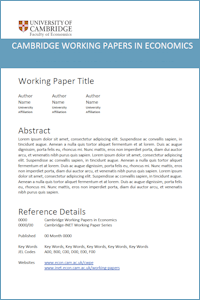
Palma, J. G.
Homogeneous middles vs. heterogeneous tails, and the end of the ‘Inverted-U’: the share of the rich is what it’s all about
CWPE1111
Abstract: This paper examines the current global scene of distributional disparities within-nations. There are six main conclusions. First, about 80 per cent of the world’s population now live in regions whose median country has a Gini not far from 40. Second, as outliers are now only located among middle-income and rich countries, the ‘upwards’ side of the ‘Inverted-U’ between inequality and income per capita has evaporated (and with it the statistical support there was for the hypothesis that posits that, for whatever reason, ‘things have to get worse before they can get better’). Third, among middle-income countries Latin America and mineral-rich Southern Africa are uniquely unequal, while Eastern Europe follows a distributional path similar to the Nordic countries. Fourth, among rich countries there is a large (and growing) distributional diversity. Fifth, within a global trend of rising inequality, there are two opposite forces at work. One is ‘centrifugal’, and leads to an increased diversity in the shares appropriated by the top 10 and bottom 40 per cent. The other is ‘centripetal’, and leads to a growing uniformity in the income-share appropriated by deciles 5 to 9. Therefore, half of the world’s population (the middle and upper-middle classes) have acquired strong ‘property rights’ over half of their respective national incomes; the other half, however, is increasingly up for grabs between the very rich and the poor. And sixth, Globalisation is thus creating a distributional scenario in which what really matters is the income-share of the rich — because the rest ‘follows’ (middle classes able to defend their shares, and workers with ever more precarious jobs in ever more ‘flexible’ labour markets). Therefore, anybody attempting to understand the within-nations disparity of inequality should always be reminded of this basic distributional fact following the example of Clinton’s campaign strategist: by sticking a note on their notice-boards saying “It’s the share of the rich, stupid”.
Keywords: Inequality, poverty, income polarisation, Latin America, South Africa, US
JEL Codes: D31 D63 N30 O50
Author links: Jose Gabriel Palma
PDF: https://www.econ.cam.ac.uk/research-files/repec/cam/pdf/cwpe1111.pdf 
Open Access Link: https://doi.org/10.17863/CAM.993
